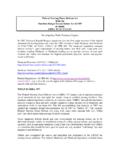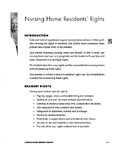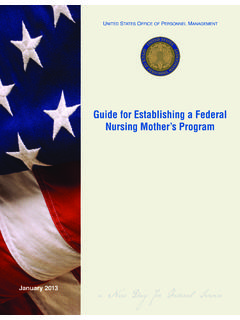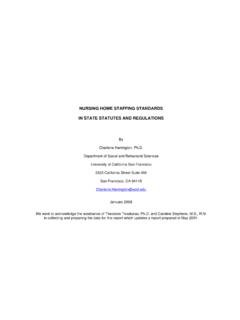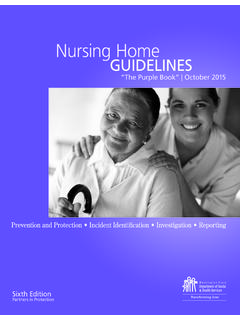Transcription of Final Rule to Reform the Requirements for Long-Term Care ...
1 Final Rule to Reform the Requirements for Long-Term Care Facilities Karen Tritz Division of nursing Homes Director Clinical Standards Group Long-Term Care Team Survey & Certification Group Division of nursing Homes October 27, 2016. Disclaimer This presentation was current at the time it was published or uploaded onto the web. Medicare policy changes frequently so links to the source documents have been provided within the document for your reference. This presentation was prepared as a service to the public and is not intended to grant rights or impose obligations. This presentation may contain references or links to statutes, regulations, or other policy materials. The information provided is only intended to be a general summary. It is not intended to take the place of either the written law or regulations. We encourage readers to review the specific statutes, regulations, and other interpretive materials for a full and accurate statement of their contents.
2 2. Background The Requirements for Long-Term Care (LTC). Facilities are the health and safety standards that LTC facilities must meet in order to participate in the Medicare or Medicaid Programs. The Requirements for Participation are found at 42. CFR 483 Subpart B. Additional guidance can be found in the State Operations Manual, Appendix PP. 4. Changes to LTC Requirements of Participation These Requirements have not been comprehensively updated since 1991 despite significant changes in the industry. The proposed rule received over 9,800 public comments, resulting in a number of revisions to the proposed Requirements . The finalized provisions reflect advances in the theory and practice of service delivery and safety, and implement sections of the Affordable Care Act (ACA). 5. Themes of the Final LTC Rule Person-Centered Care Quality Facility Assessment, Competency-Based Approach Alignment with HHS priorities Comprehensive Review and Modernization Implementation of Legislation 6.
3 Person-Centered Care Residents and Representatives: Informed, Involved, and In Control. Existing protections maintained Choices Care & Discharge Planning Prohibition on Pre-dispute Arbitration Agreements, Requirements for Post-Dispute Arbitration Agreements 7. Quality Quality of Care and Quality of Life--overarching principles for every service. Quality of Life and Quality of Care Additional special care issues: restraints, pain management, bowel incontinence, dialysis services, and trauma-informed care Quality Assurance and Performance Improvement Based on the pilot Resources available - Enrollment-and-Certification/ 8. Facility Assessment and Competency-Base Approach Facilities need to know themselves, their staff, and their residents. Not a one-size fits all approach. Accounts for and allows for diversity in populations and facilities. Focus on each resident achieving their highest practicable physical, mental, and psychosocial well-being.
4 9. Align with Current HHS Initiatives Advancing cross-cutting priorities Reducing unnecessary hospital readmissions, Reducing the incidences of healthcare acquired infections, Improving behavioral healthcare, and Safeguarding nursing home residents from the use of unnecessary psychotropic (antipsychotic) medications 10. Comprehensive Review and Modernization Bringing it into the twenty-first century Reorganized Updated Consistent with current health and safety knowledge 11. Implementation of Legislation Section 6102(b) of ACA, compliance and ethics program. Section 6102(c) of ACA, quality assurance and performance improvement program (QAPI). Section 6703(b)(3) of the ACA (Section 1150B of the Act), Requirements for reporting to law enforcement suspicion of crimes. Section 6121 of ACA, dementia and abuse training. Section 2 of the IMPACT Act (adds 1899B to the Act), discharge planning Requirements for SNFs. 12. Phased In Implementation Schedule Regulation will be implemented in 3 phases.
5 Phase 1: Existing Requirements , those Requirements relatively straightforward to implement, and require minor changes to survey process. (November 28, 2016). Phase 2: All Phase 1 Requirements , and those that providers need more time to develop, foundational elements, new survey process can assess compliance. (November 28, 2017). Phase 3: All Phase 1 and 2, those Requirements that need more time to implement (personnel hiring and training, implementation of systems approaches to quality). (November 28, 2019). 13. Phased Implementation Phase Primary Implementation Phase 1 .. Resident Rights and Facility Responsibilities*. Freedom from Abuse Neglect and Exploitation*. Admission, Transfer and Discharge*. (* this section is partially Resident Assessment implemented in Phase 2 Comprehensive, Person-Centered Care Planning*. and/or 3) Quality of Life Quality of Care*. Physician Services nursing Services*. Pharmacy Services*. Laboratory, radiology and other diagnostic services Dental Services*.
6 Food and Nutrition*. Specialized Rehabilitation Administration (Facility Assessment Phase 2)*. Quality Assurance and Performance Improvement* - QAA. Committee Infection Control Program*. Physical Environment*. 14. Phased Implementation (continued). Phase 2 Behavioral Health Services*. Quality Assurance and Performance Improvement* - QAPI. Plan Infection Control Facility Assessment and Antibiotic Stewardship **. Compliance and Ethics*. Physical Environment- smoking policies *. Phase 3 Quality Assurance and Performance Improvement* - Implementation of QAPI. Infection Control Infection Control Preventionist *. Compliance and Ethics*. Physical Environment-call lights at resident bedside *. Training *. *This section is partially implemented in other phases 15. Definitions Added federal definitions Clarification of abuse, neglect, exploitation, mistreatment Adverse event (QAPI). Nurse aide Person-centered 16. Resident Rights Combined section Significant existing language All Phase 1 changes, except.
7 Phase 2 facility providing contact information for certain organizational units (Aging and Disability Resource Center, Medicaid Fraud Control Unit 17. Freedom from Abuse, Neglect, and Exploitation Phase 1 - Strengthens existing protections, in addition to review of policies and procedures. Adds language related to resident right to be free from neglect and exploitation.. Phase 2 - Regulatory inclusion of 1150B Requirements (Reporting reasonable suspicion of a crime). This is an existing requirement under the Statute. Phase 3 - QAPI must be involved in review of allegations/incidences of abuse, neglect, and exploitation. 18. Admission, Transfer, and Discharge Rights Strengthens Requirements for discharge planning. Phase 1: all sections implemented except: (c)(2) Transfer/Discharge Documentation - Implemented in Phase 2. 19. Resident Assessment Few changes to resident assessment, but strengthened PASARR section. Implemented in Phase 1. 20.)
8 Comprehensive Person- Centered Care Planning Many of Requirements maintained - implemented in Phase 1 except Baseline care plan - Implemented in Phase 2. (b)(3)(iii) Trauma informed care - Implemented in Phase 3. 21. Quality of Life No brand new Requirements . Highest Practicable Well-Being language in this section. Implemented Phase 1. 22. Quality of Care Adds special care issues many of which were previously cited under F309 if there were care issues. Specific areas: restraints, pain management, bowel incontinence, dialysis services, and trauma-informed care. All of this section implemented in Phase 1 except trauma-informed care (Phase 3). 23. Physician Services Final removed language in proposed rule regarding physician visit prior to transfer. Ability to delegate dietary orders. All of this section implemented in Phase 1. 24. nursing Services Need both sufficient and competent staffing based on resident population. This determination is tied to Facility's Assessment (Phase 2).
9 Otherwise this section contains many existing Requirements and will be implemented in Phase 1. 25. Behavioral Health Services New requirement (incorporates highest practicable well-being, specialized rehabilitation, and medical social services). Sufficient, competent staff Resident with dementia has treatment and services needed to meet his/her needs Implementation on non-pharmacological interventions Most in Phase 2. Except- Phase 1: Comprehensive assessment and medically-related social services Phase 3: Residents with history of trauma/PTSD. 26. Pharmacy Services Protections continued (freedom from unnecessary medications and medication errors, medication storage) Phase 1. Drug regimen review and reporting Phase 2- review of medical chart Phase 2: Definition of psychotropic medication PRN usage of psychotropic medication 14 days . difference between psychotropic and antipsychotic medications 27. Other Regulations Minor Changes Primarily Phase 1.
10 Laboratory, radiology, and other diagnostic services (reduce burden non-physician practitioners orders). Dental services. (new Requirements for replacing lost dentures Phase 2). Specialized rehabilitative services. (strengthen PASRR). 28. Food and Nutrition Services Primarily Phase 1. Continues food and nutrition protections Qualified Dietary Staff sufficient and competent Updated education Requirements (dietitian and food service manager- 5 yr current employee, 1 yr new hire). Reasonable efforts to address religious, cultural and ethnic needs Snacks Policy regarding use and storage of foods 29. Administration Primarily Phase 1. Maintains Existing Requirements Licensed nursing Home Administrator Facility assessment Phase 2. Use of Arbitration (prohibition of pre-dispute, Requirements for post-dispute). Full time social worker for 120 beds + /qualifications Incorporates recent regulations (facility closure, hospice, payroll based journal).





